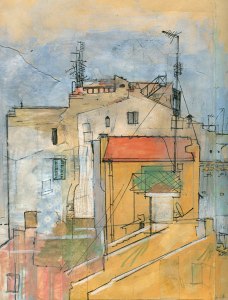Outsider art is often shrugged off as the creative work of people with a mental illness. And yes, some art brut (the French word for outsider art) is done by a human being who happens to have a mental illness. But not all. And the idea that we need to separate art into a definition of the creator bothers me.

“Alchemy” © by Quinn McDonald. Ink on watercolor paper.
Would we say “the artist who dyes her hair”? or “the left-handed collage artist? Nope. But we sure would add the elements that create a frisson of fear–and that includes mental illness, a checkered past, and other facts that divide “us” from “them.” I am an outsider artist. I don’t consider myself weird or worthy of being cast out. I just consider myself dedicated to creativity.
Jean Dubuffet, the French artist who came up with the name art brut (rough or raw art) defined it as art created outside the mainstream of the established art scene. This includes artists who have not gone to art school, who do not have gallery representation, and whose art illustrates fantasy scenes, unconventional ideas and approaches.
The magazine Raw Vision, which focuses on outsider art, includes several other definitions, including Intuitive Art. My favorite is Visionary Art, which is what the museum of outsider art in Baltimore, Maryland, calls it.
Outsider art is the creative work of people who work on the edges of the existing, acceptable art scene, and often do not make a living from their art.
Nine years ago, I made a conscious decision not to have my art be my main income. For about 15 years before that, selling my artwork paid the mortgage and bought groceries. One afternoon, I had a great idea for a piece, followed by the idea that I couldn’t create it because it was not going to be popular. And at that second I also knew I didn’t want to make creative decisions through a profit/loss spreadsheet.
Now I make a living being a creativity coach. I also design and teach business writing and business creativity workshops. And I teach art and writing workshops and retreats. And I write books. All of those things contribute to an income. When one of them threatens to drain my creativity, I shift to working on another. It keeps me fresh and takes away the onus of income producer from any one of my niches.
Most of all, it frees me to do the art I love. Several times in the past year, I’ve sighed and wished I were one of the cool artists–the ones you see all the time on Facebook, with Etsy shops and classes and lots and lots of connections. Then I realize that, since childhood, I have always wanted to be on the inside, but rarely am.
And finally, I realized the power of being an outsider. You can see what’s happening inside, but not be ruled by it. (A space at the cool kids’ table wasn’t free in seventh grade, and it’s not free now.) You can frequently be more daring, create right-on-the-edge art, and speak your truth more freely as an outsider. You can, in fact, live your creativity. Your real expression. Out loud.
Yes, sometimes it’s lonely. But other times the wonder and glory of following your vision and creating directly from your soul is worth the loneliness which feeds you.
—-Quinn McDonald is an outsider artist. She will be at CHA (Craft and Hobby Association) in Anaheim this weekend, signing her book at North Light books and demo-ing at the Niji booth.
 Before he did the portraits, he was a tattoo artist in Italy. He started drawing in 2007. It takes Diego hundreds of hours to finish a piece.
Before he did the portraits, he was a tattoo artist in Italy. He started drawing in 2007. It takes Diego hundreds of hours to finish a piece. Above: Aether, acrylic on canvas, 27″ x 44′
Above: Aether, acrylic on canvas, 27″ x 44′ He photographs sunsets, projects the photograph onto a broken 14″ x 11″ mirror in his studio, and re-photographs it. The result is a stained-glass effect of rich color and startling line.
He photographs sunsets, projects the photograph onto a broken 14″ x 11″ mirror in his studio, and re-photographs it. The result is a stained-glass effect of rich color and startling line.



